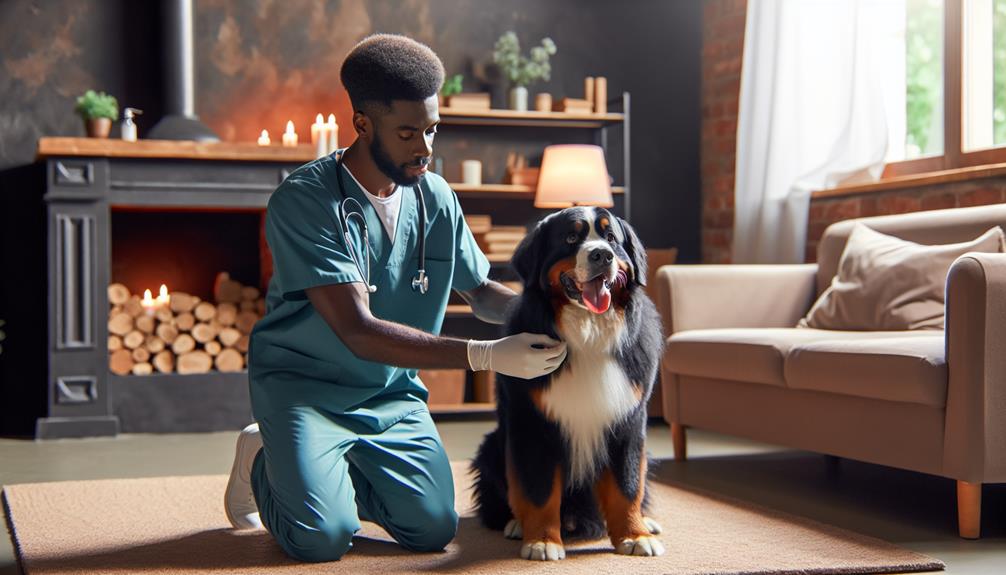If you're constantly looking for ways to keep your furry friend free from pesky fleas without breaking the bank, there are several cost-effective options available that you might not have considered yet. Taking a proactive approach and exploring alternative solutions can lead to significant savings in the long run. By thinking outside the box and tapping into lesser-known resources, you can provide your dog with effective flea treatment that won't strain your budget.
Key Takeaways
- DIY flea collars using essential oils and fabric are cost-effective.
- Utilize natural remedies like apple cider vinegar and lemon spray.
- Opt for dish soap baths for quick relief from fleas.
- Use flea combs for safe and efficient flea removal.
- Look for affordable flea treatments online through discounts and promotions.
Natural Remedies
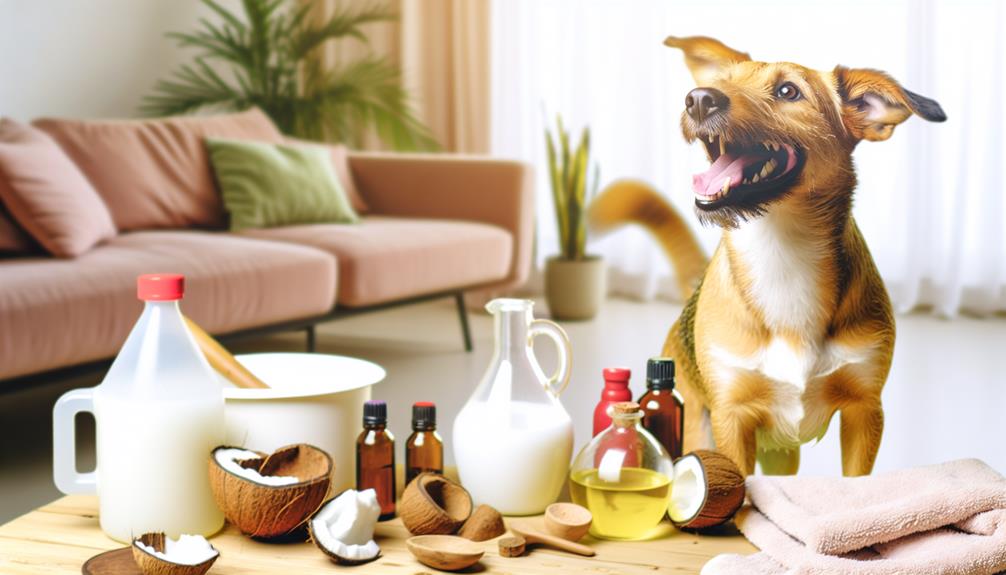
When seeking affordable flea treatment for dogs, you may consider trying out natural remedies. These remedies can be effective in repelling and combating fleas without the use of harsh chemicals.
One popular natural remedy is apple cider vinegar, which can be diluted and sprayed on your dog's coat to deter fleas. Additionally, essential oils like lavender, peppermint, and cedarwood can be mixed with water and used as a spray or applied to a dog's collar to help repel fleas.
Another natural solution is creating a lemon spray by boiling water with sliced lemons and letting it steep overnight. This citrusy spray can be used on your dog's fur after straining out the lemon slices.
Diatomaceous earth, a fine powder made from fossilized algae, is also effective in killing fleas by dehydrating them. Simply sprinkle it on your dog (avoiding the face) and rub it into their coat.
DIY Flea Collars
To continue addressing flea infestations in a cost-effective manner, consider exploring the option of making DIY flea collars for your dog. These collars can be a simple and affordable way to help keep fleas at bay without breaking the bank.
Here are some tips to create your own flea collar:
- Essential Oils: Mix a few drops of essential oils known for their flea-repellent properties with water and apply the mixture to a bandana or fabric collar.
- Apple Cider Vinegar: Soak a fabric collar in a mixture of apple cider vinegar and water to create a natural flea repellent.
- Diatomaceous Earth: Dust your dog's collar with food-grade diatomaceous earth to help kill fleas on contact.
- Herbs: Create a sachet using dried herbs like lavender, rosemary, or eucalyptus and place it inside your dog's collar to repel fleas.
Essential Oils
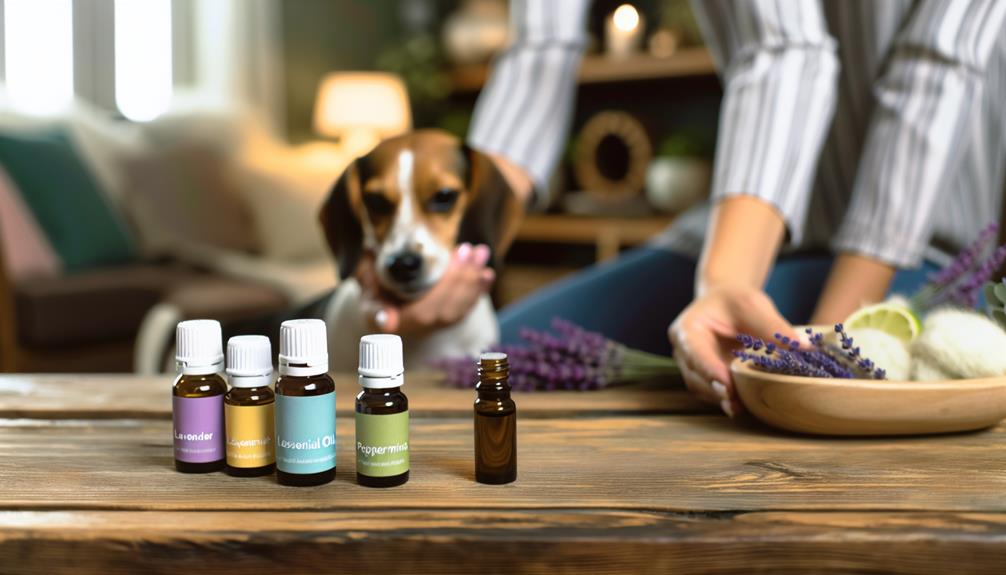
Consider incorporating essential oils into your DIY flea collars as a natural and effective way to repel fleas from your dog. Essential oils like lavender, peppermint, and cedarwood are known for their flea-repelling properties.
To make a flea collar using essential oils, mix a few drops of your chosen oil with a carrier oil such as coconut or almond oil. Soak a bandana in the mixture, let it dry, and then tie it around your dog's neck. Reapply the essential oil mixture to the collar every few weeks or as needed to keep the flea-repelling properties potent.
Lavender oil not only deters fleas but also has a calming effect on dogs due to its soothing scent. Peppermint oil is another excellent choice as fleas dislike its strong aroma. Cedarwood oil is a potent flea repellent and can help protect your furry friend from these pesky pests. Remember to dilute essential oils properly before using them on your dog to avoid any skin irritation.
Apple Cider Vinegar
Apple cider vinegar is a natural flea treatment that can benefit your dog. You can apply it by diluting it with water and spraying it on your dog's fur, avoiding the eyes and open wounds.
The acidic properties of the vinegar help repel fleas and keep your furry friend itch-free.
Benefits of Vinegar
Using vinegar, particularly apple cider vinegar, can provide numerous benefits for your dog's flea treatment.
- Natural Repellent: Vinegar's scent acts as a natural repellent for fleas and ticks.
- Balances pH: Apple cider vinegar can help balance your dog's skin pH, making it less appealing to fleas.
- Soothes Itching: Vinegar's anti-inflammatory properties can help soothe itching and irritation caused by flea bites.
- Improves Coat Health: Regular use of vinegar in your dog's diet can lead to a healthier coat, making it harder for fleas to latch on.
Incorporating vinegar into your dog's flea treatment regimen can be a cost-effective and natural way to help combat these pesky pests.
How to Apply
To apply apple cider vinegar for flea treatment on your dog, dilute it with water in a spray bottle for easy application. Start by mixing equal parts of apple cider vinegar and water in the spray bottle. Shake well to ensure thorough mixing.
Before using, test a small area on your dog's skin to check for any adverse reactions. Once confirmed safe, lightly spray the diluted apple cider vinegar onto your dog's fur, focusing on flea-prone areas like the neck, back, and belly. Avoid spraying near your dog's eyes, ears, and mouth.
Gently massage the solution into your dog's coat, allowing it to air dry. Repeat this process regularly to help repel fleas and keep your dog free from these pesky pests.
Lemon Spray

You can easily make a lemon spray at home to help repel fleas from your dog naturally.
This DIY solution isn't only effective but also budget-friendly.
Simply follow the instructions to create a natural flea repellent that's safe for your furry friend.
Natural Flea Repellent
Consider incorporating a few drops of lemon essential oil into a spray bottle filled with water for a natural flea repellent for your dog. Lemon has properties that are known to repel fleas, making it a safe and effective option for keeping these pesky insects at bay.
Here are a few tips for using lemon spray as a natural flea repellent:
- Mix 10-20 drops of lemon essential oil with 1 cup of water in a spray bottle.
- Shake well before each use to ensure the oil is evenly distributed in the water.
- Spray the mixture onto your dog's fur, avoiding the eyes and mouth.
- Reapply the lemon spray every few days or as needed to maintain its effectiveness.
Easy DIY Application
For an effortless application of the lemon spray, simply mix 10-20 drops of lemon essential oil with 1 cup of water in a spray bottle.
Shake the mixture well to ensure the oil is evenly distributed in the water.
Once mixed, lightly spray your dog's coat, focusing on areas where fleas are commonly found, such as the neck, back, and legs. Be cautious around your dog's face, ears, and eyes to avoid any irritation. Remember to avoid spraying near open wounds or sores.
Reapply the lemon spray every few days or as needed, especially after your dog gets wet.
This natural flea repellent is easy to make and apply, providing a simple yet effective solution for keeping fleas at bay.
Borax Treatment
To effectively eliminate fleas on your dog, incorporating a Borax treatment into your flea control routine can be a highly beneficial and cost-effective solution. Borax, a natural mineral compound, works by dehydrating and killing fleas, larvae, and eggs, helping to break the flea life cycle.
Here are some essential tips for using Borax as a flea treatment:
- Apply Borax Powder: Sprinkle Borax powder on carpets, pet bedding, and upholstered furniture where fleas may be hiding.
- Leave it on: Let the Borax powder sit for a few hours or overnight to ensure it penetrates deep into the fibers and reaches the fleas.
- Vacuum Thoroughly: After allowing the Borax treatment to sit, vacuum the treated areas thoroughly to remove the dead fleas and eggs.
- Repeat as Needed: For severe infestations, repeat the Borax treatment every 1-2 weeks to ensure all fleas are eliminated.
Dish Soap Bath

When dealing with fleas on your dog, a dish soap bath can be a quick and effective solution that won't break the bank.
Simply lather your furry friend with dish soap, let it sit for a few minutes, and then rinse thoroughly.
This budget-friendly option can help eliminate fleas on your dog without the need for expensive treatments.
Quick and Effective
Using dish soap for a quick and effective flea treatment on your dog is a budget-friendly option that can help eliminate these pesky pests. When using this method, remember to follow these steps:
- Gather Your Supplies: Have a tub or basin ready with warm water and a mild dish soap.
- Wet Your Dog: Thoroughly wet your dog's fur with warm water.
- Apply Dish Soap: Apply the dish soap to your dog's coat, creating a lather while focusing on flea-prone areas.
- Rinse Well: Rinse your dog completely with warm water, ensuring all soap is washed out.
This simple yet effective method can provide quick relief for your dog from fleas without breaking the bank.
Budget-Friendly Option
For a cost-effective solution in treating your dog for fleas, consider giving them a bath using dish soap. Dish soap can be a budget-friendly option that effectively helps eliminate fleas on your furry friend.
To start, wet your dog thoroughly with warm water. Then, apply a generous amount of mild dish soap, working it into a lather and focusing on areas where fleas may be hiding, like around the neck, tail, and belly. Let the soap sit for about 5-10 minutes to suffocate the fleas. Rinse your dog thoroughly, ensuring all soap residues are removed.
Repeat this process as needed, but be mindful of your dog's skin sensitivity. This simple dish soap bath can offer relief without breaking the bank.
Flea Combs
To effectively remove fleas from your dog's coat, consider incorporating a flea comb into your grooming routine. Flea combs are a simple yet powerful tool in the fight against these pesky parasites. Here's why you should make them a part of your flea treatment arsenal:
- Effectiveness: Flea combs physically remove fleas from your dog's fur, offering immediate relief.
- Safety: They're a chemical-free option, making them safe for use on puppies, senior dogs, or those with sensitivities to topical treatments.
- Early Detection: Regular combing helps you spot fleas before an infestation takes hold, allowing for prompt action.
- Bonding Opportunity: Grooming your dog with a flea comb can be a bonding experience, strengthening your relationship while keeping them flea-free.
Incorporating a flea comb into your routine is a cost-effective and efficient way to combat fleas without breaking the bank.
Vacuum Regularly
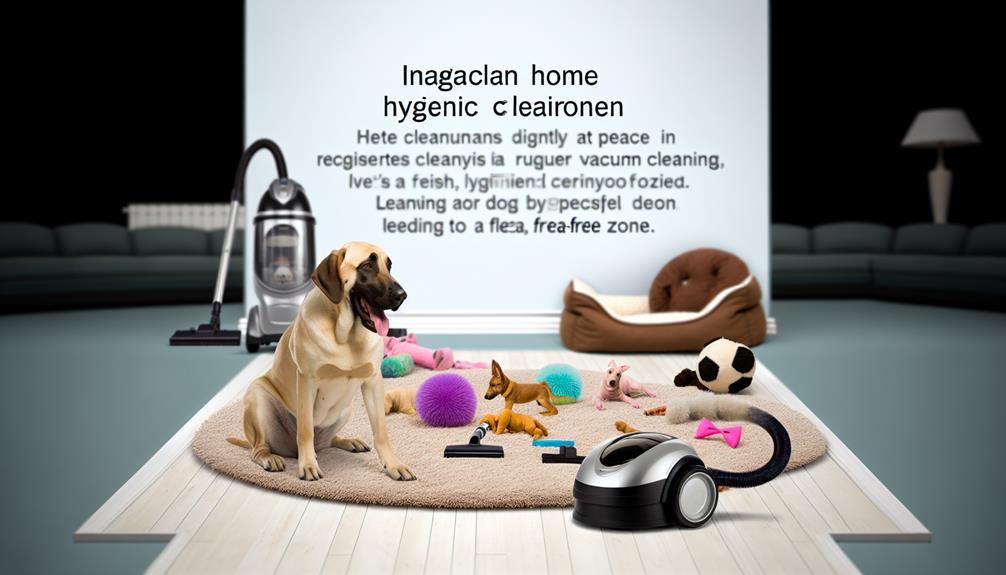
Consider the importance of vacuuming regularly to effectively combat fleas in your home environment. Vacuuming not only helps to remove adult fleas but also their eggs, larvae, and pupae, breaking the flea life cycle. Make sure to vacuum all areas where your dog spends time, focusing on carpets, rugs, furniture, and even cracks in the floor. Fleas and their eggs can hide in these areas, so a thorough vacuuming routine is essential.
When vacuuming, pay special attention to corners, crevices, and areas under furniture where fleas tend to hide. Use a vacuum with strong suction power and a HEPA filter to ensure that captured fleas and eggs aren't released back into the air. Empty the vacuum bag or canister immediately after each use to prevent fleas from escaping. Consider vacuuming at least once or twice a week, or more frequently if your flea infestation is severe.
Wash Bedding
Regularly washing your dog's bedding is crucial in combating fleas effectively. Fleas and their eggs can hide in bedding, making it a key area to target in your flea treatment routine. Here are some tips to help you effectively wash your dog's bedding:
- Use Hot Water: Washing bedding in hot water helps kill fleas, larvae, and eggs that may be hiding in the fabric.
- Choose a Flea Detergent: Opt for a flea-specific detergent or one that contains ingredients like citrus, cedar, or eucalyptus, known for repelling fleas.
- Dry Thoroughly: After washing, make sure to dry the bedding completely in a hot dryer to eliminate any remaining fleas or eggs.
- Wash Frequently: To break the flea life cycle, wash your dog's bedding at least once a week or more frequently if needed.
Yard Maintenance
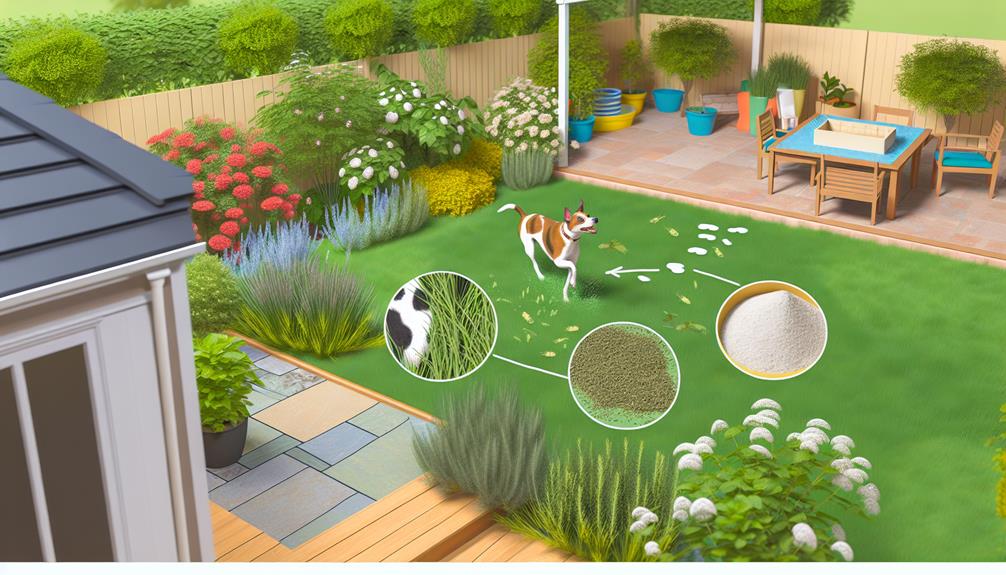
When it comes to maintaining your yard to help control fleas, remember to keep your grass trimmed short to minimize flea hiding spots.
Additionally, consider planting pest-repelling plants like lavender or mint around your yard to naturally deter fleas.
These simple yard maintenance steps can contribute to a flea-free environment for your furry friend.
Lawn Mowing Tips
Maintain a well-groomed yard by mowing your lawn regularly to promote healthy grass growth and a tidy appearance. To ensure your lawn looks its best, follow these lawn mowing tips:
- Set the Right Mowing Height: Adjust your mower to the proper cutting height for your grass type.
- Avoid Scalping: Never remove more than one-third of the grass blade in a single mowing session.
- Mow When Dry: It's best to mow when the grass is dry to prevent clumping and uneven cuts.
- Alternate Mowing Patterns: Change your mowing direction each time to prevent soil compaction and promote even growth.
Pest Control Plants
To effectively deter pests in your yard, consider incorporating pest control plants known for their natural repellent properties. Plants like lavender, marigolds, and mint are excellent choices as they naturally repel fleas, ticks, mosquitoes, and other unwanted insects.
Lavender not only adds a lovely fragrance to your yard but also deters fleas and moths. Marigolds contain pyrethrum, a natural insect repellent that can help keep pests at bay. Mint plants, such as peppermint and spearmint, can repel fleas and ants with their strong scent.
Over-the-Counter Treatments
For dog owners seeking budget-friendly flea treatments, over-the-counter options provide a convenient and cost-effective solution. These treatments are easily accessible and can help in managing flea infestations without breaking the bank.
Here are some effective over-the-counter flea treatments for dogs:
- Flea Collars: Flea collars are a popular choice for pet owners looking for a long-lasting solution. They release chemicals that repel and kill fleas on contact.
- Topical Spot-On Treatments: These treatments are applied directly to your dog's skin, usually between the shoulder blades. They're effective in killing adult fleas and preventing flea eggs from hatching.
- Flea Shampoos: Flea shampoos are an affordable way to quickly kill fleas on your dog. While they may not provide long-term protection, they can offer immediate relief.
- Flea Sprays: Flea sprays can be used to treat your dog, as well as their bedding and living areas. They're a versatile option for targeting fleas at different stages of their lifecycle.
Prescription Medications
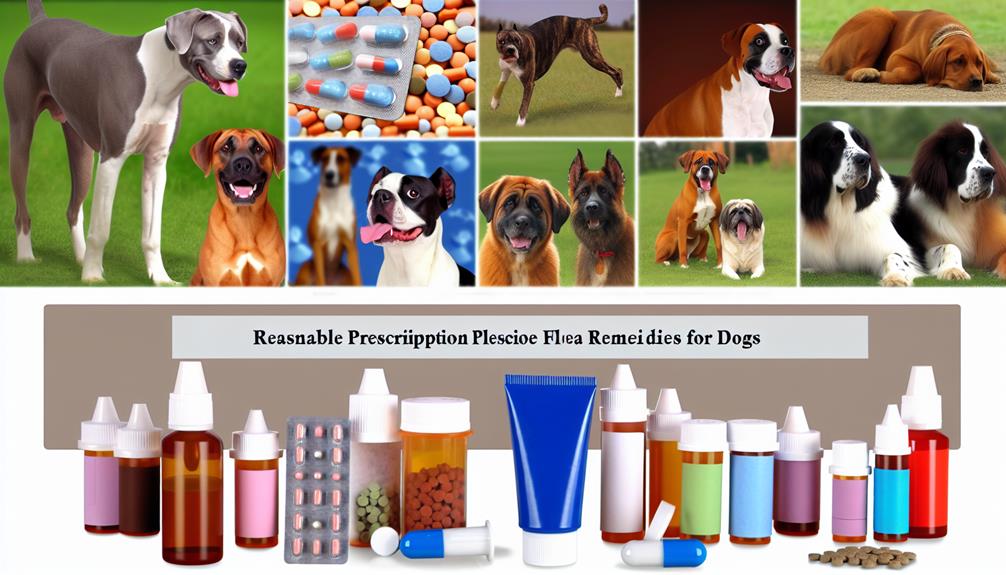
If you're considering advanced flea treatment options for your dog, prescription medications offer effective solutions that require veterinary approval. These medications are often more potent and targeted compared to over-the-counter treatments, making them a suitable choice for severe flea infestations. Your vet will assess your dog's specific needs and prescribe the most appropriate medication based on factors like your dog's age, weight, and overall health.
Prescription flea medications come in various forms, including topical treatments, oral tablets, and injections. Topical treatments are applied directly to your dog's skin, usually between the shoulder blades, and provide long-lasting protection against fleas. Oral tablets are ingested and work from the inside out to kill fleas when they bite your dog. Injections are administered by your vet and offer extended protection against fleas.
While prescription flea medications may be more costly than over-the-counter options, they're often more effective in controlling and preventing flea infestations. Remember to follow your vet's instructions carefully when using prescription medications to ensure the safety and well-being of your furry friend.
Online Discounts
Considering prescription flea medications for your dog? Online discounts can be a valuable resource for saving on these effective treatments. When looking for affordable flea treatments online, keep the following tips in mind:
- Subscribe to Newsletters: Sign up for newsletters from online pet pharmacies to receive exclusive discounts and promotions directly to your inbox.
- Check Coupon Websites: Visit coupon websites that specialize in pet products to find discount codes for various flea medications.
- Follow on Social Media: Follow your favorite pet supply stores and flea medication brands on social media platforms to stay updated on flash sales and limited-time offers.
- Compare Prices: Use price comparison websites to quickly compare the cost of flea medications across different online retailers and choose the most affordable option.
Preventative Measures
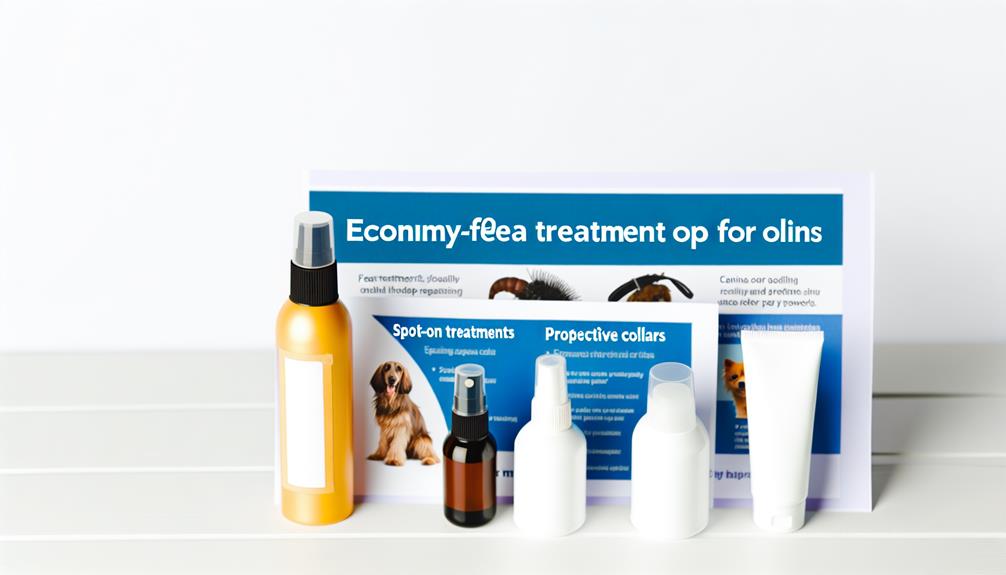
Implementing regular preventative measures is key to keeping your dog free from fleas and ensuring their overall well-being. Start by maintaining a clean environment in your home. Regularly vacuuming carpets, washing your pet's bedding, and keeping your living spaces tidy can help eliminate flea eggs and larvae. Additionally, grooming your dog regularly can help you spot any signs of fleas early on. Use a flea comb to check for any pests and keep your dog's fur clean and well-trimmed.
Another important preventative measure is to administer flea preventatives recommended by your veterinarian. These can come in various forms such as spot-on treatments, oral medications, or collars. They work as a barrier to prevent fleas from infesting your dog and can be a cost-effective way to avoid expensive flea treatments in the future.
Lastly, be cautious when taking your dog to areas where fleas are common, such as parks or wooded areas. Always check your dog for fleas after outdoor activities and consider using natural repellents like apple cider vinegar to deter fleas. By implementing these preventative measures, you can help protect your furry friend from flea infestations and keep them healthy and happy.
Frequently Asked Questions
Can Flea Treatments for Dogs Be Harmful to Other Pets in the Household?
Flea treatments for dogs can potentially harm other pets in the household due to toxic ingredients. Always ensure proper application and monitor pets closely for any adverse reactions. Consult with a veterinarian for safe and effective flea treatment options.
How Often Should I Treat My Dog for Fleas to Prevent Re-Infestation?
To prevent re-infestation, treat your dog for fleas every 4-8 weeks. Consistent application of flea treatment is crucial for your pet's well-being. Consult your veterinarian for guidance on the best schedule based on your dog's specific needs.
Are There Any Side Effects Associated With Natural Flea Remedies for Dogs?
When considering natural flea remedies for dogs, remember that some may cause mild irritation or allergic reactions. Always monitor your pup closely after treatment and consult a vet if you notice any unusual side effects.
Can Fleas in the Yard Be Eliminated Without Harmful Chemicals?
You can eliminate fleas in the yard without harmful chemicals by regularly mowing the lawn, trimming bushes, and removing debris where fleas hide. Consider using nematodes or diatomaceous earth as natural alternatives to keep your yard flea-free.
Are There Any Home Remedies That Can Help Soothe Flea Bites on Dogs?
To soothe flea bites on dogs, you can make a mixture of oatmeal and water to create a paste. Apply it to the affected areas and let it sit for a few minutes before rinsing off.
Conclusion
In conclusion, by utilizing natural remedies, DIY solutions, over-the-counter treatments, and online discounts, you can effectively and affordably manage flea infestations in your dogs.
Taking preventative measures such as regular grooming and keeping your pet's environment clean can also help prevent future flea outbreaks.
With these cost-effective options and proactive approaches, you can keep your furry friend happy, healthy, and flea-free without breaking the bank.

